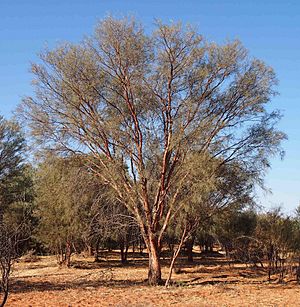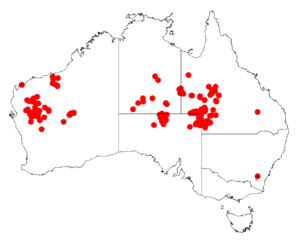Creekline miniritchie facts for kids
Quick facts for kids Creekline miniritchie |
|
|---|---|
 |
|
| Scientific classification | |
| Genus: |
Acacia
|
| Species: |
cyperophylla
|
 |
|
| Occurrence data from AVH | |
The Creekline Miniritchie (scientific name: Acacia cyperophylla) is a special type of tree. People also call it the Red Mulga. It belongs to the pea family, called Fabaceae. This tree grows in dry and partly dry areas of Central Australia. You can find it from Carnarvon in Western Australia all the way to western Queensland and eastern New South Wales. It likes to grow where the soil is a bit wetter, like along rivers and creeks.
Contents
What Does It Look Like?
The Creekline Miniritchie can grow up to about seven metres tall. That's like a two-story building! It usually has one or two main tree trunks.
Like many Acacia trees, it doesn't have regular leaves. Instead, it has something called phyllodes. These are like flattened leaf stems that do the job of leaves. The phyllodes on this tree are stiff and round. They are about two millimetres wide and between ten and fifteen centimetres long. They also have a gentle curve.
The flowers of the Creekline Miniritchie are bright yellow. They grow in long, cylinder-shaped groups. Each group is about two centimetres long. After the flowers, the tree grows pods. These pods are wide and flat. They are about eight centimetres long and seven millimetres wide.
Special Bark
One of the easiest ways to spot a Creekline Miniritchie is by its unique bark. It has "minni ritchi" bark. This means the bark constantly peels off in small, curly flakes. It makes the tree look like it has a coat of curly hair! On the Creekline Miniritchie, this special bark is an orange-brown colour.
Different Types and Protection
There are two main types, or varieties, of Creekline Miniritchie. They are A. c. var. cyperophylla and A. c. var. omearana.
The A. c. var. omearana variety is very rare. It is only found in a few places near Port Hedland. These small groups of trees are currently at risk. Because it is so rare, A. c. var. omearana has a special protection status. It is listed as "Priority 1" under the Western Australian Wildlife Conservation Act. This means it is a very important plant to protect. Experts are even thinking about calling it "rare flora" to give it more protection.
Images for kids
See also
 In Spanish: Acacia cyperophylla para niños
In Spanish: Acacia cyperophylla para niños


